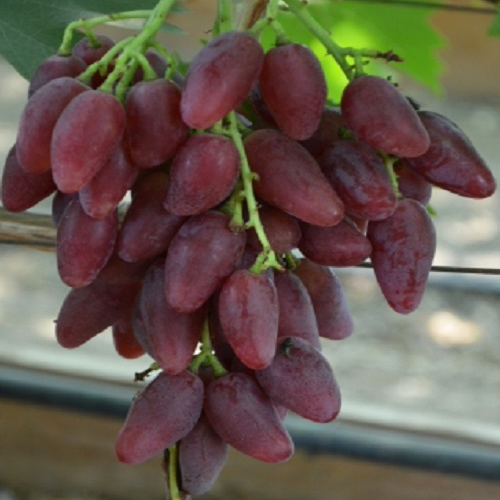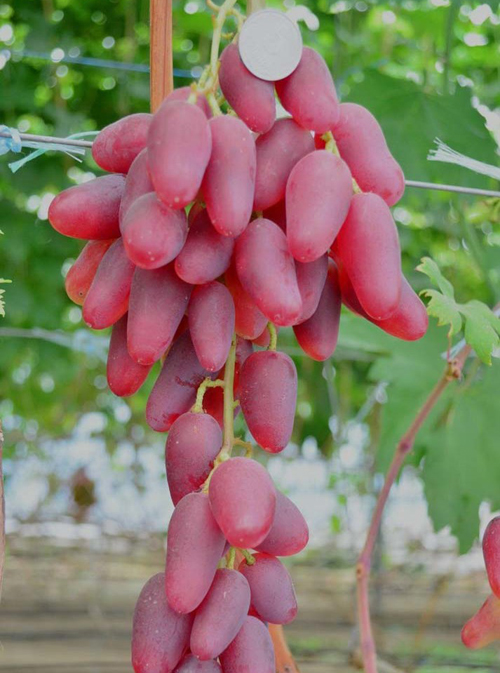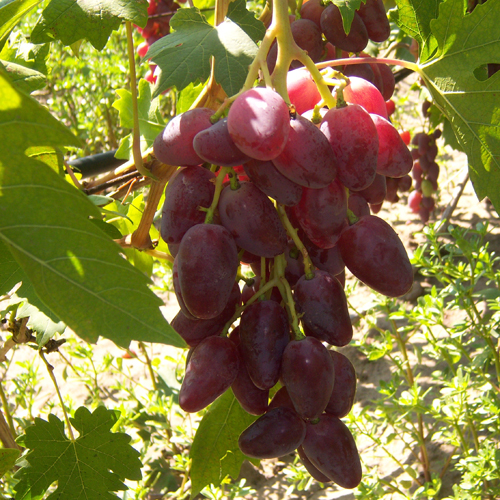Grape variety Dubovsky pink
The breeding of new grape varieties by amateur breeders does not stop for a single year. Every season, enthusiasts present new products, obtained by them as a result of the most diverse and numerous crosses. The best forms quickly become hits, they are trying to get them by all means, not only wine growers-producers, but also the same folk breeders who are already using them in their work to obtain more and more outstanding hybrid forms.
Have not stopped krainowski yet Anniversary of Novocherkassk called a new variety, and already with its participation as a parent form, the newest table hybrid appeared with even more impressive characteristics of bunches and berries. The author of the next masterpiece, called Dubovsky pink, was Sergey Eduardovich Gusev from the city of Dubovka, Volgograd region. He has more than two hundred author's developments in his collection, and the number of rejected unsuccessful results can not be counted at all, but it is Dubovsky pink, the author admits, by far the most famous of all his many brainchildren.

And this popularity did not come from scratch. The grapes, which were born in 2009, instantly attracted the attention of winegrowers from all over the country and neighboring countries thanks to a truly gigantic bunch in size and corresponding berries with an elegant pink color and a very unusual icicle-like shape with a curved tip. And this is without taking into account the relative simplicity in cultivation and high sugar content, which our hero was endowed with by the second parent - the well-known resistant variety of the VNIIViV them. ME AND. Potapenko Delight is red. Such a complex of characteristics made Dubovsky pink a real bestseller, and brought its author to the list of the most famous folk breeders.
Currently, the hybrid form is undergoing state variety testing. Sergey Eduardovich collaborates on this issue with the North Caucasus Federal Scientific Center for Horticulture, Viticulture and Winemaking. And numerous fans of the new hybrid, meanwhile, are testing it themselves, convinced of the excellent aesthetic and taste qualities of grapes and the advantages that it demonstrates from the point of view of agricultural technology.
Agrobiological characteristics
In own-rooted culture and grafted on vigorous rootstocks, bushes of this variety are distinguished by rapid and powerful development. The crown of a young shoot is smooth, shiny, green with a noticeable bronze tint, without pubescence. The leaves of Dubovsky pink are large in size, rounded in shape, openwork, deeply dissected into five lobes. The notches between the lobes are closed with a rounded gap, or open lyre-shaped with a narrow mouth and a rounded bottom. The petiole is open, of medium width, with parallel sides and a flat bottom. The surface of the leaf blade is smooth, there is no pubescence on the underside. The teeth along the edge of the plate are large, saw-shaped, with even edges and sharp tops. The flower is bisexual, does not show problems with pollination. The grapes are not prone to peeling and excessive loosening of the clusters. The maturation of one-year growth occurs without problems and along the entire length. A well-ripened vine is able, according to the author, to withstand frosts down to -24 ° C. There is no objective data on this yet, so the growers are reinsured by covering the bushes for the winter.

The bunches of Dubovsky pink are very large in size, their mass on an adult bush starts from one kilogram, and on average they weigh 1.2-1.5 kg, conical in shape, moderately dense, impressive and very attractive in appearance. The comb is strong, can easily withstand weighty brushes, light green in color. The berries in a bunch are located freely, do not deform.They are excellent in size and shape - up to 60 mm long, up to 30 mm in diameter, elongated, conical, with an original curvature of the tip. The weight of the berries reaches 20 grams, the average weight is in the range of 14-15 grams. They are painted in an elegant pink color, in many respects repeating the colors of the Novocherkassk Jubilee variety. In different climatic conditions, shades of color can vary from light golden pink to very saturated. The pulp of the grapes is also pink in color, crisp in consistency, juicy, with a pleasant taste, but without specific notes in the aroma. The sugar content of the berry juice is high, "vostorgskaya" - 21 grams / 100 cubic cm. There is no data on acidity, but according to taste, the ratio of acid and sugar is very harmonious. The skin is thin, moderately strong, practically not felt when consumed. The wax coating on the skin is light, medium intensity. There are very few seeds - one, sometimes two, and in a large volume of berries they occupy a scanty part. The tasting score of Dubovskiy pink, shown in the first years of the state test, was 9.3 points.
The grape harvest is successfully used for fresh consumption. Today, the bunches of this hybrid form can be called one of the most attractive and demanded on the market, due to the original appearance and large-fruited. Even the magnificent representatives of the famous "Krainov's troika" look somewhat faded next to Dubovskiy pink. Its only drawback is the side effect of its main advantage - giant bunches weighing one and a half to two kilograms do not always find their buyer, and even eating them at one time seems problematic. The variety's suitability for long-distance transportation and long-term storage is average due to the rather thin skin, which is also a certain cost of the high taste of grapes.
Ripening of the crop occurs very early. The growing season from bud break to the onset of ripeness of berries is 105-115 days. In the south, the first bunches can be cut at the beginning of August. The total amount of heat required for maturation is 2300-2350 ° C (SAT). Thanks to this, Dubovsky pink is quite capable of being cultivated in the northern regions with a relatively short and cool summer. Cleaning in this case will shift to late August - early September.

The grapes begin to bear fruit very early - in a self-rooted culture a year after planting. The productivity of the variety is high, the first growers who received full harvests testify to the productivity of at least 10 kg per bush. The average number of clusters per fruitful shoot is close to two, which is why the hybrid is classified as prone to overload. In addition, it has a high ability to plant a second crop on stepchildren, which in the south ripens successfully in autumn, but lags far behind the main crop in terms of large-fruited.
After the onset of removable maturity, clusters of Dubovsky pink can continue to hang on the bushes without a high risk of cracking or decay. Many pioneers of the variety confirm its resistance to this kind of damage even in unfavorable seasons for ripening conditions. At the same time, it is necessary to provide protection from wasps for the bunches of grapes, since due to the thin skin of the berries, these pests can cause significant damage to the ripening crop.
Agrotechnical features
Given the novelty of this hybrid form and its insufficient knowledge, recommendations for cultivation may be very conditional and far from complete. The grower will have to comprehend a lot himself, closely observing the development of the plant, testing them on his own and sensitively reacting to the results of these tests.
The ability of Dubovskiy rosea to resist attacks of phylloxera root is unknown, and therefore, in case of soil contamination with this pest, the planting of bushes should be carried out grafted onto rootstocks resistant to phylloxera. Reproduction of grapes by rooting cuttings is possible only in regions free from this scourge.
Shelter of young plants for the winter, due to the high cost of planting material and the lack of information on the frost resistance of the variety, should be done everywhere. But matured bushes in traditional regions of viticulture can be recommended to be grown according to a semi-covering scheme. To do this, the main part of the plant is formed on a high trunk with powerful arms and cordons without shelter for the winter, and closer to the ground, a covering lightweight layer is formed, which serves as a reserve in case the main part dies from frost. Thus, you can kill several birds with one stone: significantly reduce labor costs for covering the bushes entirely, really test the winter hardiness of the variety in the climatic conditions of a particular area, and if the test is successful, get a well-developed powerful bush with a large supply of perennial wood, showing the best indicators for large-fruited and the quality of the bunches. And all this without the risk of losing the entire bush due to the overestimated frost resistance of the vine, because from the reserve part it will always be possible to restore the plant skeleton damaged by frost. In the same regions where the thermometer often drops below the -24 ° C declared by the author, there is no point in conducting additional tests. Here it is definitely necessary to form grape bushes according to covering schemes (multi-arm fan, inclined cordon), and annually produce high-quality insulation of the vines in the fall.
The resistance of Dubovsky pink to fungal diseases, according to the available fragmentary information, is above average, but it also requires verification. Here it is worth recommending spraying the variety from mildew and oidium during the period of their highest harmfulness (before and after flowering), and then, during the growing season, carefully observe the plants, responding to specific outbreaks of the development of any pathogen. Do not forget to observe the waiting time, therefore, less than 2-4 weeks (depending on the drug) before the onset of ripeness of the bunches, chemical treatments can no longer be carried out. Use only approved chemical plant protection products and strictly follow the instructions for their use.
The regulation of the load on fruiting vine bushes must be done with great care due to the tendency of the variety to overburden the crop. In the spring, when pruning, Dubovsky pink is loaded with 35-40 eyes, shortening the fruit arrows moderately - up to 6-8 eyes. After the start of the growth of shoots, those that are weak and sterile are ruthlessly broken off. On fruitful shoots, extra bunches are also removed without regret, leaving only one at a time. During the summer, pinching is regularly performed so that the bush does not thicken and is well ventilated. For the same purpose, leaves are removed around the bunches during the ripening period, making the so-called "lightening". In addition to improving the microclimate in the fruit zone, such a technique will serve as an additional prevention of the development of fungal diseases on the hands. At the same time, such an event should be carried out with caution in the south, since in the parental form of Dubovsky pink, the Anniversary of Novocherkassk, in bright sunlight, the bunches ripen quickly, while the berries remained faded, not having time to get their elegant pink color.
In general, recognizing the highest potential of the already famous hybrid form of grapes bred by Sergei Eduardovich Gusev, it should be noted that there is an immense scope for inquisitive minds from among winegrowers-practitioners. With the help of their own research and experimentation, everyone will be able to develop a unique approach to the newest variety, taking into account the local specifics of its cultivation, ultimately gaining the greatest satisfaction from the fantastically attractive hand-grown bunches.








